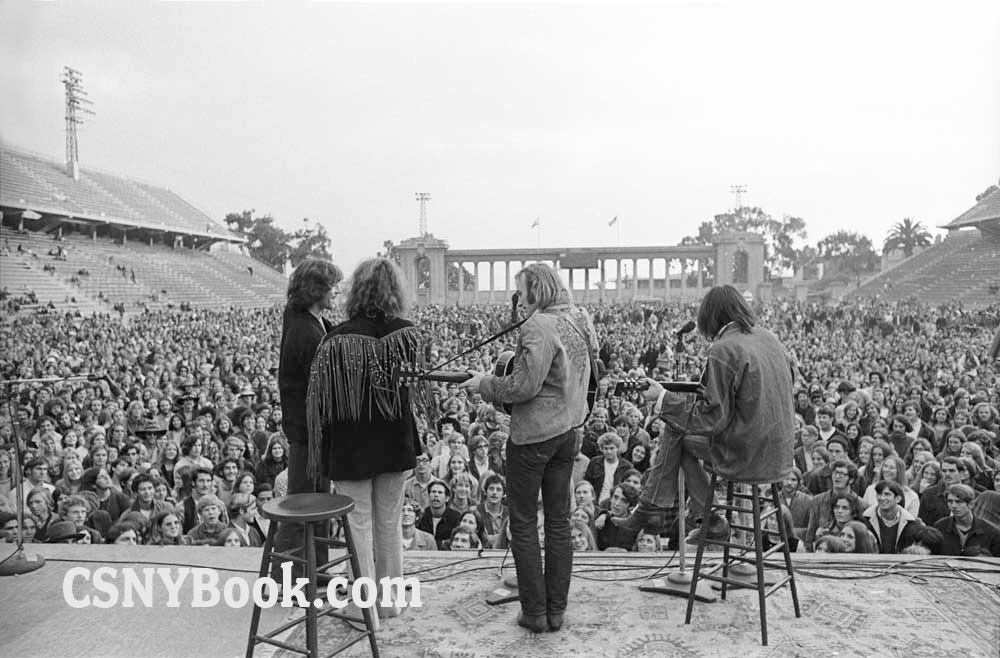
In the Laurel Canyon music scene, few left as indelible a mark as Crosby, Stills, Nash and Young. Their harmonies and diverse musical approach defined the sound of the era, and behind the lens, preserving the essence of CSN&Y’s journey, stood renowned rock photographer, Henry Diltz. As a fellow musician and a close friend of the group, Henry Diltz’s camera has been a constant companion. Jason Barnard sat down with Henry to uncover the moments that shaped CSN&Y’s legacy.
Henry, the new Crosby, Stills, Nash and Young book, ‘Love The One You’re With’ is a stunning collection. The quote from Graham Nash in his forward that ‘It was just like hanging out with a friend’ really resonated. That came across in all your photographs. They’re very different to some of the staged shots that many photographers do. They’re much more natural and it takes you back into each photo.
Yeah. That’s all I know to do really. I wasn’t a photographer. I was a musician. I was in a folk group performing for five years back and forth in the US. Recording and singing and all that. One day leaving a city in Michigan after we’d done a show the night before at a college, as we were pulling out of town, we spotted a secondhand store. You have to pull in and look and see what’s in there. So we pulled in and right inside the door was a table full of secondhand cameras. And the guy right in front of me and my group, Cyrus Faryar, as he walked by, reached down and grabbed one. He said, “Oh, a camera. I need one”. And I was behind him and without even thinking about it, I just in a reflex action said, “Oh, me too”. I grabbed one. I’d never been thinking about getting a camera. Not at all. Three of us bought cameras and Cyrus, knew about them. He said, “Let’s pull into the next drugstore and I’ll buy film for everybody.” He gave us all a box of film. And I said, well, “Okay, I put the film in and how do you set these numbers?” He said, “Look on the box”, a yellow Kodak film box. It said sunlight. 250 at eight. So I said, “Okay, 250 at eight. Let’s go out in the sun”.
So that was my school, that film box. And we took photos of each other for the next couple of weeks on the way home to LA. So we each had a handful of film that we got developed. And I was surprised when it came back from the lab to see they were little slides, little transparencies, you can hold them up and look. I said, “Wow, look at that”. I didn’t know what the pictures would even look like. And I said, “Well, then let’s have a slide show”. Invite all of our hippie friends. And we had a slideshow. These eight feet wide glowing in the dark, these adventures that we had had in the past few weeks. And I said, “This is amazing. I’ve got to take more of these so we can have more slideshows”. It was kind of a social event. It was fun. And that’s what started me out taking pictures of all my friends in Laurel Canyon. And they were all musicians, Stephen Stills and Mama Cass, David Crosby, all these people that I hung out with because I was a musician. And then one by one, these people in Laurel Canyon became famous. So that was a good thing for me.
It was Buffalo Springfield that was the first photo that you were paid for. Is that right?
That is right. I bumped into Stephen Stills one afternoon, or it was early in the day. Whatever time of day! I bumped into him and he said, “Hey, Henry, the Buffalo Springfield is going to the beach to a folk club in Redondo Beach tomorrow. Would you like to come along? And I thought, yeah, I would like to come along to go down on the beach and photograph people while they’re doing their soundcheck. Which is what I did. And after about a half hour, I walked back to the club and I was real busy photographing a big mural on the back of the club and I had it all framed up because it was very colourful. And I like to have colourful pictures in my slideshows. It had my friends, but they weren’t music photos, except there were some musicians in there. But I would look for colourful things, interesting, funny things, to get a reaction from my friends. I thought, well, that’s big and colourful, the whole building is painted with this mural. And just as I was focusing on it, the back door opened and these guys walked out right next to the mural. And I said, “Hey, you guys just stand there in front of that if you would for a minute, so I could show how big it is”. And I didn’t think anything of it. I took a whole roll of film because they started acting up and making faces. And then a week later, a magazine called and said, we hear you have a picture of the Buffalo Springfield. We’d like to run it, we’ll pay you $100. And that was, wow, $100. I hadn’t made a penny yet, from taking a picture. So that was my first sort of paying gig.
It doesn’t seem that long afterwards when Mama Cass led you to taking photos of The Hollies? The UK cover of For Certain Because, that’s your work, isn’t it?
Yeah, that was also the first year I got a camera, 1966. So I took that picture. Early on, a friend of mine, Eric Jacobson, who produced the Lovin Spoonful. He was a real good friend of mine from the folk music days and a fellow folk singer. He said, “Henry, I hear you wanna become a photographer. Why don’t you fly back to New York for the summer? Because the guys, the Spoonful needed a lot of photos.” They had just had a big hit with ‘Do You Believe In Magic’. He said, “We’ll pay for all your expenses and you’ll learn to be a photographer”. So while I was there that summer, the phone rang in the lead guitarist’s house, Zal Yanovsky. And it was Mama Cass. She said, “Are you guys gonna be there for a little while? I’d like to bring some friends by”. And Mama Cass was an earth mother. She would meet these English boys on a TV show, the first time in America, type of thing. And she’d say, “Oh, you don’t know anybody. Let me take you around and introduce you. Let me call some friends.” So she came by a short time later with The Hollies. And it was great. We spent the afternoon drinking margaritas and telling road stories and laughing. And then Graham said, “Oh, Henry, you’re a photographer. We need some new pictures. Could we come around tomorrow?” And so they came around the next day and I did. So my first group was the Buffalo Springfield. Then it was the Lovin Spoonful and then The Hollies, all kind of at the same time.
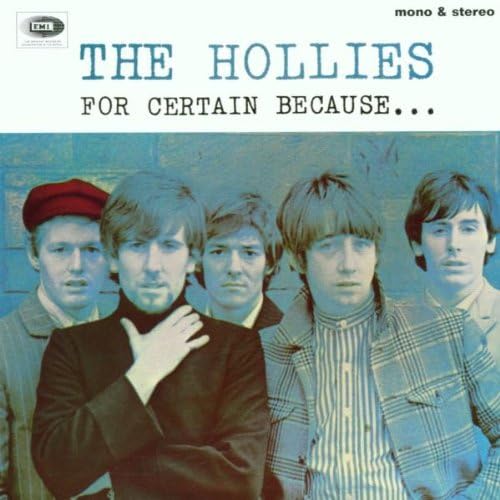
There’s a great quote of David Crosby’s, where he talks about the Modern Folk Quartet, your group, and loving the harmonies of your group. So he was a big admirer of the band.
He was an admirer of the band. And Stephen Stills as well. The first year we were travelling around the country, we would play a jazz club in New York called the Village Gate because we were sophisticated folk music. We wore suits and we sang four-part harmony, kind of like the Four Freshmen, singing folk music. And so often we opened for jazz musicians because we had sophisticated chords. And Stephen, in 63 we were playing there and Stephen was a real young boy singing in a coffee house down the road. He came to hear us and would sit on the edge of the stage and listen to our harmonies. The harmonies were really, really good, really interesting. I think I met Stephen first, that was 63, I believe. Then I met David on the road somewhere or where he was singing, our paths crossed somewhere in 64. And then 66 was Graham. So I knew these guys years before they ever became Crosby, Stills and Nash. It’s funny, I think about it. I think, well, wow, I’ve photographed these guys for half my life. But then I really started doing the math and it turns out it’s two thirds of my life. [laughs]
With the Modern Folk Quartet, you recorded with Phil Spector for the single ‘This Could Be the Night’. There is a Beach Boys sound to it.
There was. Phil Spector was in town here and we were playing all the clubs and he’d come in and see us and he felt that he wanted to do a sort of, the new folk rock sound. And so we arranged to rehearse with him over a summer. We’d go up to his house, three, four days a week and sit around and play songs and rehearse. He played the piano and said, “You sing this”. He was kind of grooming us. And then one day he said, “I have a song for you”. It was called ‘This Could Be the Night’ by Harry Nillson. And we went in and we recorded that with the wall of sound. First day we did the track, the second day we did the vocals. And that afternoon when we were in there finishing up the vocals, we looked in the control room and there was Brian Wilson sitting there with his robe and slippers, and he was way overweight, sitting there during that period of time. And he was our hero, we would sing Beach Boy songs on the way to a gig to warm up. And we’d go [sings] “Round, round, get around, I get around”. And it was amazing. Wow, we thought, we’ve made it. Brian Wilson was listening to our song over and over. We didn’t even go in there. We didn’t even talk to him. We couldn’t. He was our hero. I don’t know why, but we didn’t. And then we waited around for a few weeks and then a few months waiting for that song to come out so that we could reap the glory? And it never came out. He never released it. And we kept calling the office, “No, Phil’s off in New York. We don’t know. He’ll be back in two weeks”. And we never could get an answer. So I know what it was because I played on a few other songs of his that never got released. It was one by The Ronettes. There was a song by the Ronettes called ‘A Paradise’. And he liked the sound of my banjo in the background with all the guitars, you know, just going da, da, da, da… and I played on that song and that never came out either. It was a beautiful song. He was pretty paranoid that if he put a song out and it didn’t go right to number one, there would go his reputation. So a year or two later, our song and that Ronettes song came out on an album in England called ‘Rare Masters’. And that was the first time we heard it on a record. By that time, a couple of the guys had moved back to Hawaii. Then we got together several other times over the years, but that was a funny, a funny time. Yeah, it was great making a record with the great Phil Spector. He was quite a character. I can imagine.
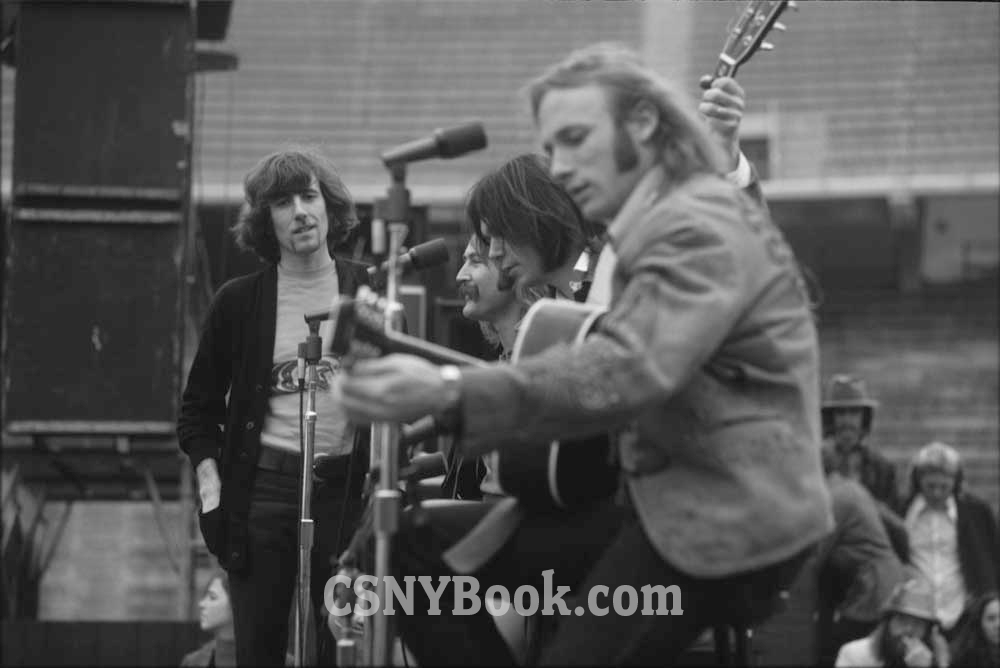
Your new book follows up another Genesis Publications book, ‘California Dreaming’. Out of any photographer of that time, your photos embody the Laurel Canyon scene and you were there at the heart of that living there. What was it that made Laurel Canyon special and why do you think the scene emerged in that area?
Laurel Canyon, it wasn’t a magical place. It was just a convenient place because it was right up the hill from Hollywood, from the sunset strip where all the clubs and record companies were just five minutes up the hill and you were in the countryside. And there were owls at night. You’d park your car late at night. You’d hear whoop, whoop, whoop, up in the tree. And there were coyotes and raccoons. You were in the country. And the reason it was up in Laurel Canyon, over the years, people had built little summer cabins up there on the hillside. But there were no proper houses with yards. There were no yards for children to play. There were no sidewalks. They were just curvy hills. If you go up to Laurel Canyon expecting to see something amazing, all you see are these curvy hills with cars parked on each side. Where’s the magic? The magic happened as single people lived up there, actors and musicians. We all just drifted up there because it was the most convenient place nearby to rent a little place. And so it was virtually almost all musicians and some actors living up there. And then every night we’d go down the hill to the Troubadour Club where we all got together almost every night. And I would see David Crosby in there, plenty. Almost every night. And he was a fan of ours. I remember one time we were playing there and in the dressing room he was saying, “Man, you’re so lucky. You get to sing harmony with your friends”. And I said, “Well, David, don’t worry. You’ll get there”. Kind of thing. Oh, man, it was funny. [laughs]
Given that you were friends with the band members, you were in that scene, you were there at the very start of Crosby, Stills and Nash’s formation. You’ve got some amazing shots of them in the studio in that early period. And as well in this book as well, you’ve got many of the people on the scene with quotes from them such as Judy Collins talking about ‘Judy Blue Eyes’. What was it like in that period? It must have been so exciting to see something special come together.
The late 60s. I photographed in 66, in 64, the Beatles played Ed Sullivan. That was kind of a turning point because all the folk groups wanted to see who these guys were. We’ve heard a lot about them. I’ve never really seen them before, I’ve heard a little bit on the radio, but I don’t get it, you know. We pulled into a motel that night on the road to watch the Ed Sullivan show. And our first reaction was, “oh, look, they have an electric bass.” We had a stand up bass, so we’d carry on the airlines and carry in the van with us. And it was big and bulky. And so by the next week, we had an electric bass, and we electrified all our instruments. And that’s why the Buffalo Springfield got together. They were folk musicians. Same thing with The Byrds. And we all were quite influenced by the Beatles. And the other thing was, in folk music, you never write a folk song. It’s a 100 year old song, right? But here were the Beatles singing, ‘She loves you, Yeah, yeah, yeah’. And I mean, we’re thinking, wow, why are we singing about the Ox Driver? We could be singing something more fun and lively, like they are. That’s when it affected everybody. All these musicians started writing their own music. It wasn’t only because of the Beatles. Bob Dylan in New York had written a Talking Blues for Woody Guthrie because he really liked Woody Guthrie. It was a renaissance and a flowering and a golden era of singer-songwriters. I’ve often said this, Frank Sinatra never wrote any songs. Elvis Presley never wrote any songs. There were songwriters and singers. But after the middle 60s, the singers were singing their own songs. So when you could see someone like Joni Mitchell sing her own feelings, what was in her heart and in her mind, which was considerable in her case. And in each of these cases, the cleverest singers would start writing their own feelings about life and love. And it was way more interesting to hear somebody’s, You take Jackson Browne, wow, what a guy. The words to his songs and then he sings them like anthems. They’re just so beautiful. It just makes it so much more amazing when a person sings their own story. And that’s what happened. And that was a big change, a sea change in the music industry.
There are a few shots in this book as well, going to Joni Mitchell’s house to take shots of Ladies of the Canyon as well. Again, a really natural pose. You really put her at ease.
By that time I was working with a graphic artist, Gary Burden, and he’s throughout that book. He was a great guy and I would take 500 pictures. He would look through them overnight and pick out the one that was going to be the cover. He was so good at it. And also he was fun to hang out with. He was a couple of years older than we were. He just was interesting. And a great personality. So that day we were just going to Joni’s house to take some publicity photos. And as we walked up the steps to her house, she was leaning out the window. And she said, “Hey, good morning guys. And we stopped to talk. And Gary talked to her for about five minutes right there in the window. And that gave me the chance to take these pictures. So not having gone to photo school myself. I didn’t learn lighting. I never shot in a studio. I wasn’t interested in that. In fact, for me, it was less about photography and more about hanging out with your friends and just being there to watch what happens, just having access. I’ve always been curious about people. When I was in college, before all this happened, I was studying psychology, not to be a psychologist, but to learn about people, how they act, why they act, who are we, what are we supposed to do, what are we doing?. And I’ve always been really, really curious about people. I found out more recently that my Chinese animal is a tiger. And tigers like to hide in the bushes and watch the other animals. And that’s exactly what I do. I remember in those days, people would see me with a camera and say, “Oh, you’re a photographer, are you a professional?” And I would say, “No, no, not really. I just take pictures of my friends”. I never really thought of myself as, okay, I’m here to take the picture. It was more like, hey, how are you doing? Then when I just sit and watch and when it’s interesting, I take the picture. I’m interested in documenting what really happens. I don’t want to make it happen, you know. Okay, you guys put on these funny hats and stand against that wall over there and look over here and smile, you know. That’s not my style. I just like to look and observe. And when it’s interesting and it frames up nicely, I push the button.
It’s interesting you talk about being a people watcher. So from a musical perspective, adding Neil Young to Crosby, Stills and Nash was quite an interesting combination and at times he would bring a bit more of a bite to the group, like with ‘Ohio’. But what was he like relating to the other three?
All the times I’ve ever been with Neil, it’s always very kind of up and happy. Usually he laughs a lot. I know he can be moody. He is a Scorpio. Scorpio is quite a strong astrological sign. Joni Mitchell is a Scorpio too. Generally, they know what they want, they don’t suffer fools lightly, and they either like it or they don’t like it. There’s no in between. And so he was very definite in what he wanted to do. He was funny, he really laughed a lot. I always have to say, all of us back then in the 60s were having a little toke of God’s herb, it was a way of life. Years later, we have a gallery called the Morrison Hotel Gallery where we sell all these pictures. And one day I was standing there, in the early days, it was only my pictures, 100 pictures on the wall. And a guy, walked in, he said, “Did you ever smoke grass with any of these people?” And I looked around the room and I said, “every single one, except for Donny Osmond, and maybe Michael Jackson.” His brothers probably smoked it, but he didn’t. It was left over from the jazz days. It wasn’t a big deal, but it was kind of a way of life. And the thing is, smoking a little bit of those flowers. It raises your attention, your interest in things. It accelerates your senses a little bit. And it heightens your senses, right? So you wanna reach for your guitar? It just makes the day a little bit brighter. By golly, it does, you know, when you get into the man-made powders, those are very bad.
Talking about grass. The photo of David Crosby, the American flag and the gun, that’s iconic. How did that happen?
Well, that was their first gig out of town, their first travelling trip. They went from LA to Minnesota, Minneapolis. And we were staying in a hotel there. And they were going to do their first concert together away from LA. And I was in David’s room talking to him. And of course, he was sitting on the bed, smoking a joint, like always. And in fact, he was talking on the phone to Bob Dylan. And I thought, “Wow, that’s so great”. He was smoking a little and Graham Nash opened the door and said, “Hey, Cros, a fan made this for you and threw this flag gun on the bed. It was like a little pillow, a stuffed American flag in the shape of a pistol. And David was sitting there with the joint and he just reached down, picked up the flag gun and put it to his head and took a little joke. And I went click. So you might think, hey, we’ve got a great idea. Now we want you to sit there. I want you to hold this and pretend you’re smoking a joint. No, no, no, none of it’s ever, ever staged, it’s just real life. That was, I liked that moment.
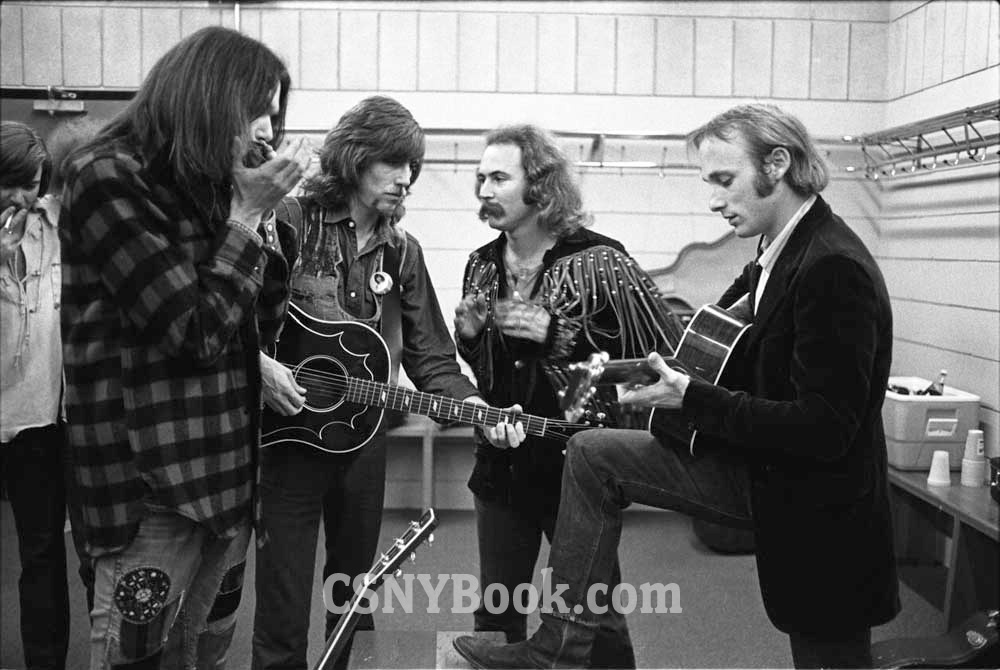
You continued to chronicle the band members including in the late 90s for the Looking Forward album. How did the dynamic between them change over the years?
In the beginning, there were the three boys who loved singing together, they would hit that three-part harmony and it was heaven to them and to the listeners. They loved the harmonies they made and they were really very excited about it, and pretty knocked out that they could do it. And then I guess for the second album, maybe their manager, the record company or what said, you know, we need a little more ass in the music. And Stephen had always loved playing with Neil Young and the Buffalo Springfield because they had this rivalry. One guy would play a line on the guitar and then the next guy would have to answer that a little bit better. They would go back and forth that way. Stephen, I think, missed that and Neil was his friend and they said, “Let’s get Neil in the group”. So Neil was kind of a maverick, He came with his own songs and then they would sing harmony on his songs. So it was like a two-part thing. There were the three of them and the songs that they all wrote and then Neil and his songs. So it encompassed a couple of worlds there. Neil was great. Whenever I was with him, he was always laughing and having a good time. It was usually with a group of people. I’ve been up to his ranch a few times and stayed over there for a weekend and he was very gracious, very, very fun loving, very open and up for anything funny. I’d be up there with Gary Burton, who was a really good friend of his. But maybe that’s why it was always so upbeat, but I know sometimes he would get a notion in his head like, he wouldn’t want to go on the road and he just left and they couldn’t stand that. So like I say, you know, I wouldn’t say he wasn’t moody, but I mean, as a Scorpio, they say, well, I don’t want to do that. Or I do want to do that. And a couple of times he said, “No, I don’t want to do that”, and he’d just leave. But luckily they had that core group of the three of them and they could do any concert with the three of them. But he was that way with the Buffalo Springfield as well, he would come and go. He didn’t sort of owe any allegiance to anybody. He was his own man, that was the thing. But that’s what makes Neil, right?
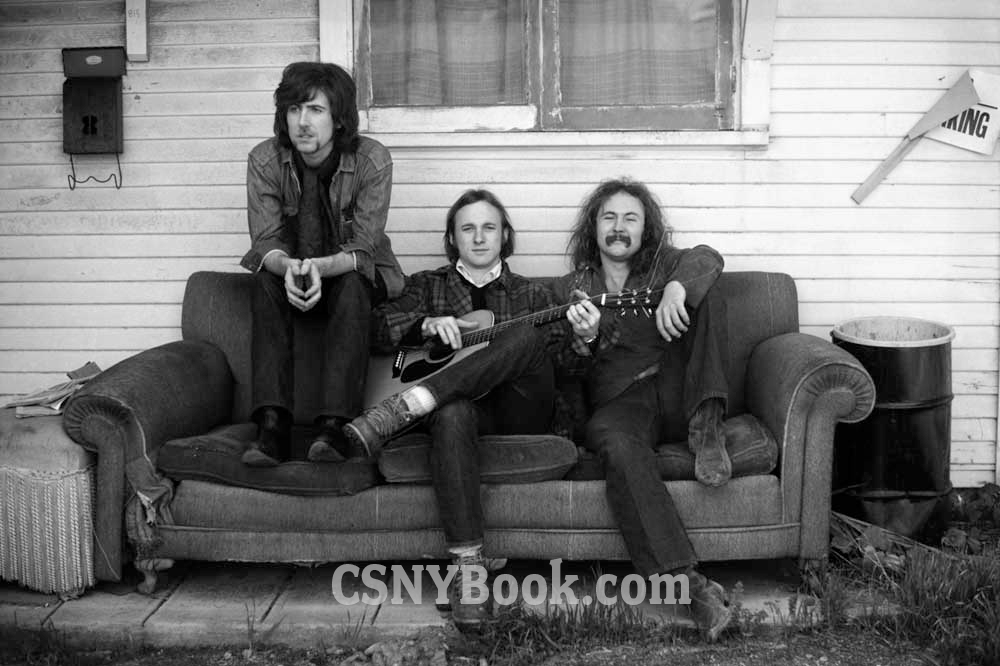
Looking across your photos with them, one of the most iconic photos is them on the couch for the album cover. It’s just amazing how you’d see a brilliant opportunity for a fantastic photo and you’d capture them at the right moment for the Crosby Stills Nash album.
We were actually taking publicity photos. They were in the middle of recording their first album, and they didn’t have any photos. And at that time, we all belong to a kind of a club. Musicians all belong to a club, they’re all very close that if you meet a musician, and you’re a musician, your brothers, and not only that but Lookout Management which became Geffen-Roberts. It was a big management company with Elliot Roberts and David Geffen. And they managed Neil and Joni and CSN and America, The Eagles, Joe Walsh, Dan Fogelberg. They managed most everybody and we were a part of that group. We’d be down there at the office every day, using the phone to make a call, flirting with the secretaries, smoking a joint, and, and it was a way of life and so we photographed all those people. We just sort of became the in-house group that did the publicity and album covers. So there were no photos of them performing. They didn’t even have a photo to put in Billboard to announce that they were recording. So we went out one afternoon in Gary Burden’s old Ford station wagon, and we drove around West Hollywood and we jumped out a few places to take photos. And Graham had seen an old house with a couch out in front of it and we finally found it up a side street. He said “There it is!” so everyone jumped out and jumped on the couch and the same thing happened with Gary and I as a team. I would get up close and I was just framing the couch. The couch was a perfect rectangle. That was the frame that I used. So I had the couch perfectly framed up close. Then Gary Burden said what he always said to me, “Back up, back up, get the whole house”. Evidently as a graphic artist, he had an idea to maybe use the whole house in a photo. Then what we do then is develop the film and have a slideshow and look at the pictures. Well, that happened and everyone liked that picture. They said, “Wow, that would make a great album cover. But in the time, the couple of days that you were developing the film, we decided to call ourselves Crosby Stills and Nash. And we’re backwards in that picture.” Because they weren’t named that yet. I remember people talking about how we could flip the picture over. Then it would be Crosby Stills and Nash, but Stephen would be playing the guitar backwards. And so I remember saying, “Let’s just go back. Let’s just drive back to the house, jump on that couch in the right order. It’ll take five minutes. So we all got in Gary’s Ford station wagon and drove there and there was no house. The house was gone. It was a vacant lot. And it was right around the time Joni Mitchell wrote that song, paved paradise, put up a parking lot. That’s exactly what happened. So they used it that way. But it wasn’t planned. That day we weren’t out to seek an album cover. A lot of times that happens. You’re just taking photos and then you get a good one and they say, “Wow, we could use that”.
You’ve talked about listening again to some of the Crosby Stills and Nash songs like ‘Helplessly Hoping’, and the lyrics really hit home to you, even though they go back 50 years. And part of the magic of the group is that the songs are as special now as they were back then.
That song ‘Helplessly Hoping’, I’ve heard it, what, 200, 300 times? I mean, every time they ever play. I mean, and I knew it was Helplessly Hoping, something, something. Sometimes, I would go to a Neil Young concert and shoot photos and a friend would say, “Wow, you went to Neil Young concert. What songs did he do?” And I’d say, “I don’t know. He did all those Neil Young songs. I was watching, I wasn’t listening.” Of course I’m listening, but I’m really concentrating on the visual part of it. And, I don’t sing along with it. But of course, I’m aware of all of their music, but I couldn’t sit down and sing a whole song. And then about a couple of years ago, right in the middle of the pandemic, on YouTube, I don’t know how I heard about it, but there was an Italian acapella group that recorded ‘Helplessly Hoping’. And you would look at that and on the screen would be a little Italian girl and she would go, [affects Italian accent] Helplessly hoping her harlequin hovers nearby. It was, wow, it was just so touching, and then another second voice would come in and a second girl, then someone else, someone else, until there’s 20 people singing that song. It grew and grew and grew and it was just a beautiful choir singing. And that’s when I really listened to the words, and said, this is, this is an amazing song. I knew he’d written it for, for Judy Collins, but the idea that helplessly hoping, her harlequin, which would be him, Stephen, hovers nearby, awaiting a sound, a sign, something like that, waiting, waiting for Judy to notice him, the whole song is about that. He’s just hovering around hoping she’ll say something to him. And oh man, it’s, it’s heartfelt, it’s beautiful. And it gave the song a new life for me. That’s for sure. It’s become, become a big deal. I have a Friday night dinner party with people who love that song. And after dinner, we put that on the computer and we all sing along to it. I hope those guys are just getting famous as hell, because god, they were great. You look on YouTube and there’s 20 versions of helplessly hoping, but then you put in ‘il coro che non c’è’. It doesn’t mean helplessly hoping. It means the heart doesn’t know or something like that.
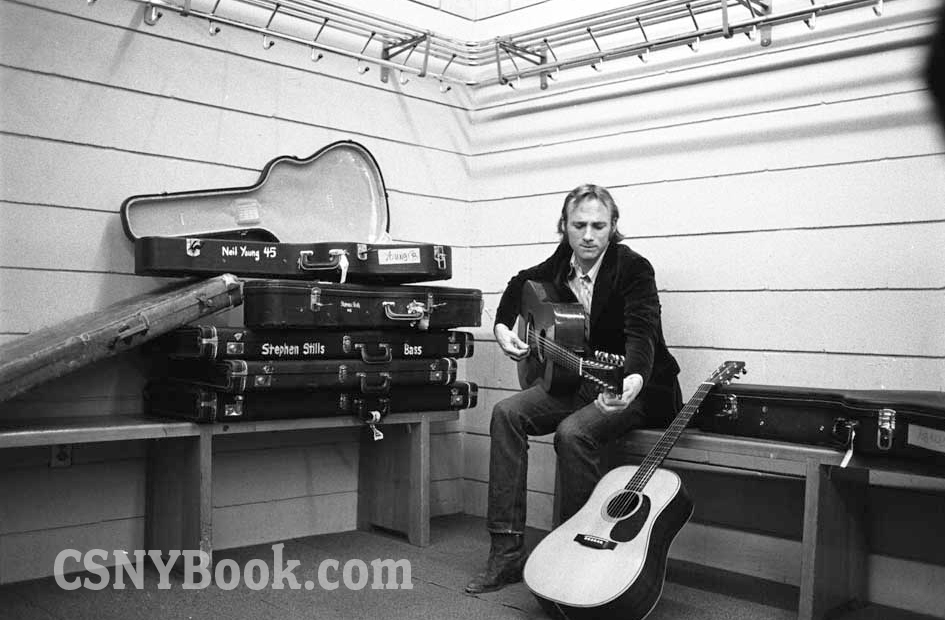
Over the years, I’ve been around those guys, as singles, duos and groups. I spent half a year in England living at Stephen Stills house in Elstead Surrey and we took a lot of photos there. We did his second album cover there. And once again, I’ve never taken a picture of Stephen for an album cover. You know, we were in Colorado and it snowed one night and he wanted a picture of him out singing in the snow when I took a picture. a year later it got used for an album cover. And then we were in England and we wanted to go to Paris to see Steve McQueen who was doing a racing car movie. And Stephen wanted to go there. We never did find him because the crew had moved on to somewhere else. But we got on the ferry. We rented a stretch Mercedes limousine to drive to Paris. We weren’t supposed to take it out of the country, but we got right on a ferry boat, and we went and sat down in the coffee bar on the ferry. And Stephen was sitting across from me and I raised my camera to take a picture and he turned his head and looked out the window and I took the picture anyway. And that became the album cover of the second album, a year later. It happened that way often.
And in that period when you were over here in the UK, you had Mick Jagger coming over, Peter Sellers as well. Stephen’s love of horses. I didn’t know that.
Yeah, he loved horses. He was living in a house that Peter Sellers had lived in. And then he sold it to Ringo Starr. And I guess he’d sold it or leased it or rented it to Stephen Stills. And it had a stable, but no horses. So one day we drove off, he’d gotten the name of an Irish horse trainer guy. And we went to his farm near us. And there was a big steeplechase horse named Major. And that’s the horse Stephen wanted. But Major had a little pal who was a little spotted pony who was his friend. And the Irish guy said, “You can’t just take him. You’ve got to have the little horse, too.”And the horse’s name was Crazy Horse, or Stephen named him Crazy Horse, right away. And so he’d go out there and ride every day. He loves horses.
It’s been a pleasure to talk to you, Henry. The Genesis Publications book, ‘Crosby, Stills, Nash and Young – Love the One You With’. Even if you’ve got a passing fondness for CSNY, this is an essential book and a perfect accompaniment to listen to all that wonderful material. Thank you very much.
Thank you very much, Jason. Pleasure talking to you. Peace and Love!
Further information
CSN&Y: Love the One You’re With – Henry Diltz, Graham Nash, Stephen Stills and over 20 contributors
Audio version of this interview – Henry Diltz podcast.
All photos by Henry Diltz – used with permission.
